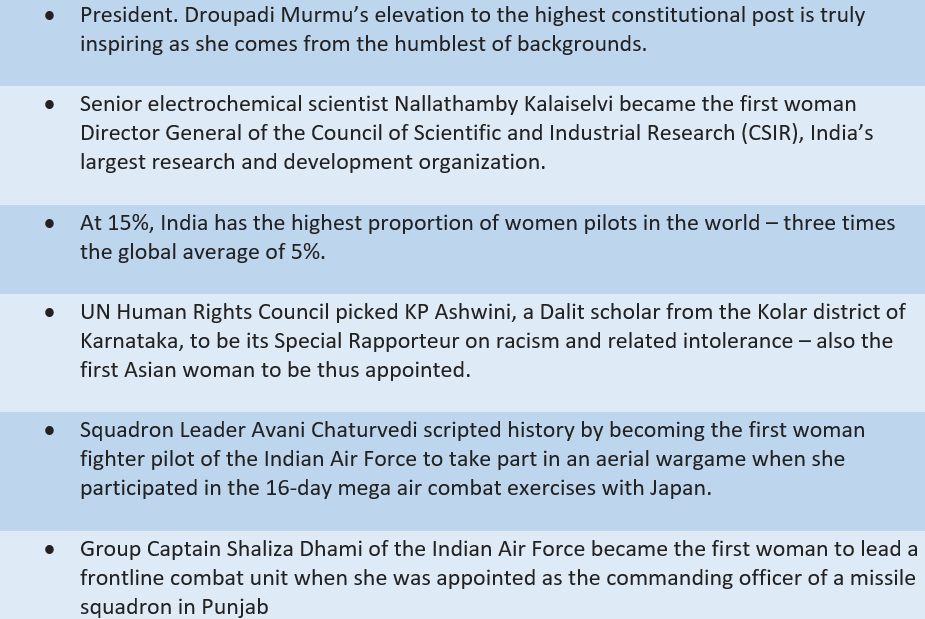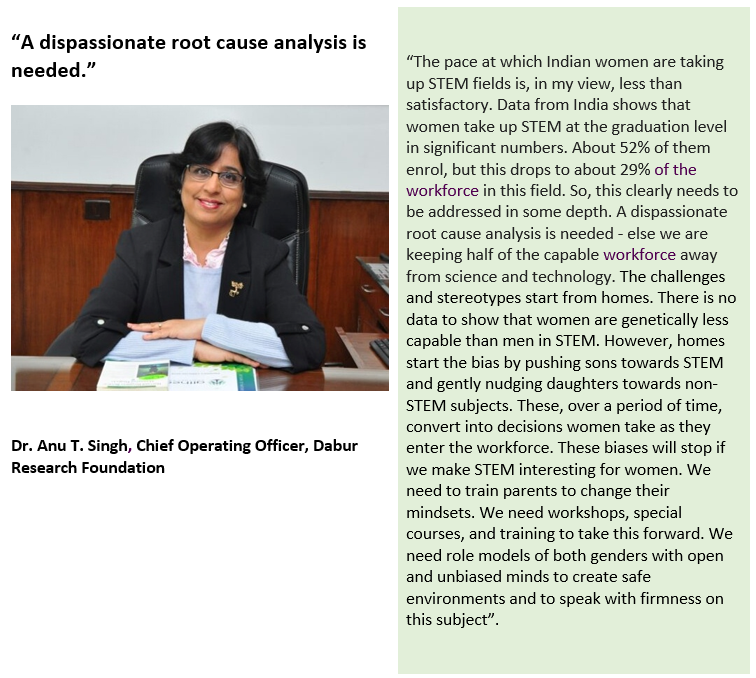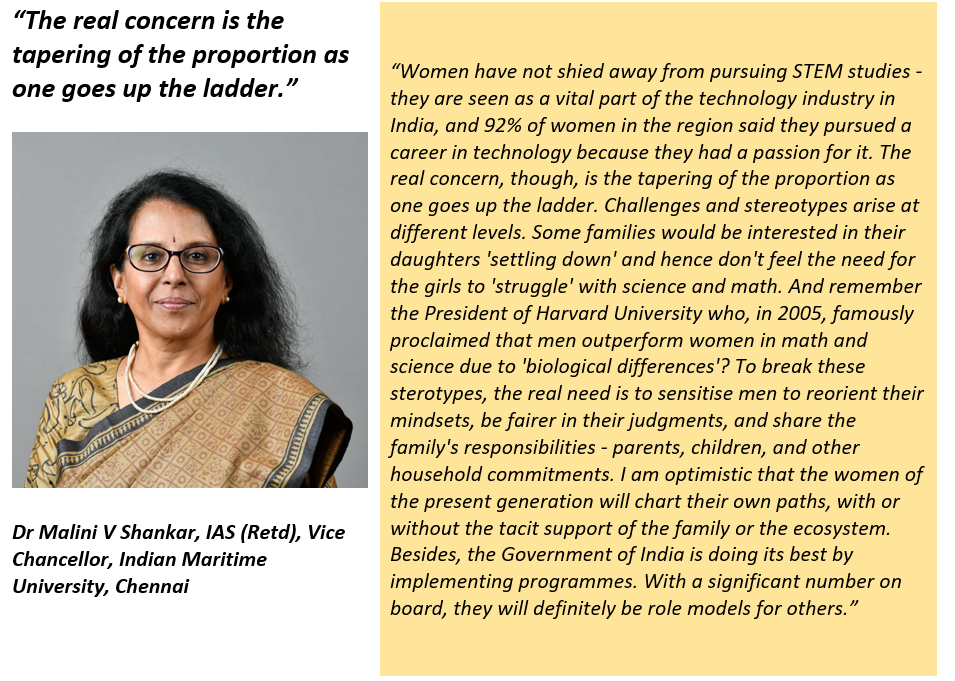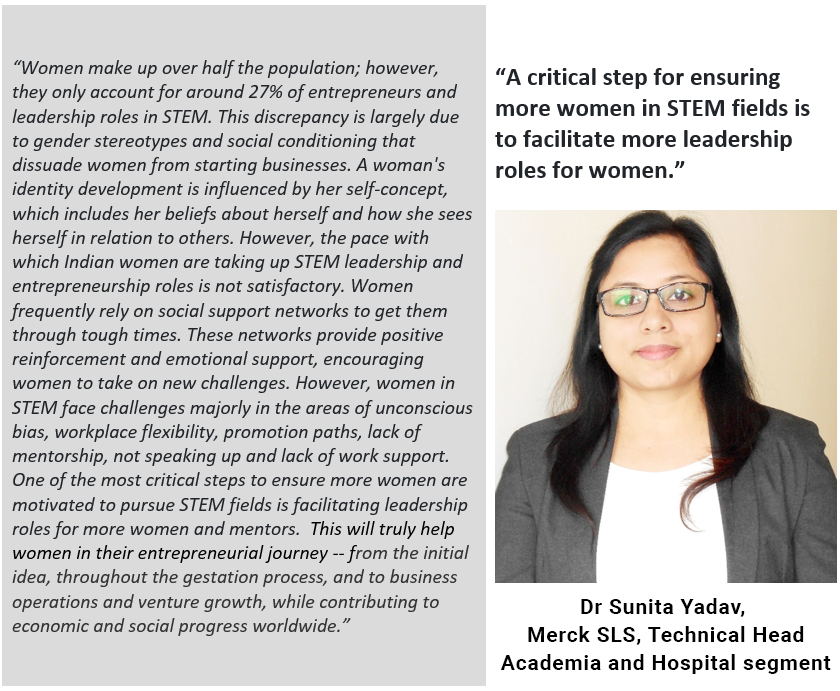23 March 2023
What’s Trending?
STEM-ing The Tide
With advancements in the Science, Technology, Engineering & Maths (STEM) domain, there are immense opportunities for Indian women in sectors traditionally considered men-dominated. A look at the game-changers and roadmap in the STEM Field to iron out gender biases
India had a lot to celebrate this International Women’s Day. In the past 12 months, Indian women set many milestones as the country continued its march towards development and social and gender equity.

Advantage India?
Although Indian women have been surging ahead in all fields, STEM (Science, Technology, Engineering and Mathematics) is collectively a discipline that’s most notable for the future in terms of innovation and technological development. Success in STEM-related careers and entrepreneurship is a barometer of women’s empowerment in society as this field has been one of the hardest male bastions to break into.
Globally, governments and policymakers are encouraging women to take up STEM education and careers to bridge the yawning gender gaps and inspire more women, thereby harnessing gender equity and economic growth.
STEM accounts for the lion’s share of new jobs being created worldwide. Some of the fastest-growing and highest-paying jobs relate to STEM fields, such as Artificial Intelligence (AI), Data Science, Information Technology, Medicine, Environmental Sciences, Genetics and Engineering.
India enjoys a relatively high percentage of women STEM graduates compared to the global average. Girls comprised 29% of enrolments in engineering and technology and 48% in science in 2020-21, according to the All-India Survey on Higher Education (AISHE) conducted by the Union Ministry of Education. With good precedents and role models to follow, more young women are likely to be encouraged to pursue this stream.
Furthermore, these figures are impressive compared with the global averages. According to a World Bank report, just 18% of girls enrolled at the tertiary level pursue STEM studies globally.
The problem persists as women quit at different stages of education or employment, and the numbers diminish as they go higher in the academic or professional hierarchies. Over 81 per cent of women engineers reported having to prove themselves repeatedly to get the same level of respect as their male counterparts, inherent biases against marriage and motherhood, confinement to a narrower range of acceptable behaviours, and unhealthy competition for the ‘one woman spot’ available. Losing trained women scientists or other STEM professionals especially is a great loss to both science and the nation, not to mention the career setbacks for the individuals themselves.
It all begins at the smallest unit of society – the home where STEM is still largely perceived as a male domain. Dr Anu T. Singh, Chief Operating Officer, Dabur Research Foundation, agrees that the challenges and stereotypes start from home. “There is no data to show that women are genetically less capable than men in STEM. However, homes start the bias by pushing sons towards STEM and gently nudging daughters towards non-STEM subjects,” she says.
Such attitudes leave a debilitating effect on girls’ motivational levels and self-confidence about pursuing STEM. Dr Malini V Shankar, IAS (Retd), Vice Chancellor of Indian Maritime University, Chennai, offers an interesting perspective, “Challenges and stereotypes arise at different levels. I have come across employers who are impressed with the knowledge, skills, and leadership potential of women and yet, they tend to be concerned about the 'lost years' when the woman is obliged to take time off to start a family to the detriment of the company,” she says.
In the presence of such prejudices, women may feel stuck and quit their STEM jobs for options that provide better gender parity and career growth.
Building Them Up -- Role models and mentors, because ‘it’s hard to be what we cannot see.’
Studies have found that female leaders and role models who have succeeded in male-dominated fields influence girls’ preference for STEM studies by demonstrating mindsets and behaviour on how to ‘achieve’. Fewer role models, in a way, on the other hand, will perpetuate the ‘women not meant for STEM’ dogma.
Dr Sunita Yadav, Merck SLS, Technical Head Academia and Hospital segment, feels that one of the most critical steps to ensure that women are motivated to pursue STEM fields is to facilitate leadership roles for more women. “By seeing women as role models and mentors, a woman is more likely to take on new challenges and reach her full potential as an entrepreneur," she says.
Mentoring is key to the success of a STEM student. A positive and tangible mentor can provide immediate and individual solutions to women who have broken the barrier and opted for higher education in STEM. These could pertain to college or career advice, a balanced social life, recommendation on courses or research projects to opt for or a new leadership position to fill. Leading by example, a friendly and reliable mentor helps young women gain confidence in their chosen areas of expertise. Many universities are making available STEM women-based mentorship programs that help mentees apply their passion to expertise under guidance from experienced mentors, while at once being inspired by success stories.
Small steps for giant leaps
Extraordinary efforts and innovative solutions must be harnessed at all stages of the pipeline – enrolment, graduation, employment, retention, and leadership. These can come about through the synchronisation of efforts, including policy decisions and mass sensitisation at the family and social level through advocacy campaigns, at campuses and workplaces.
• Gender and diversity imbalances in STEM cannot be addressed through a single piece of legislation. A proactive education system that encourages consistent curiosity, questioning and opposition to unscientific stereotypes from the primary school level would build a solid foundation.
• While the government has successfully run the Beti Bachao, Beti Padhao programme, it could also be adapted to the Beti Ko Science Padhao slogan with the same infrastructure.
• A crossroad is approached at the high school/university level where they specifically opt for STEM subjects to major in. While teachers and parents have a critical role to sensitise girls, the government policy of introducing supernumerary seats for women at IITs was a milestone. As per the Union Minister of State for Education, IITs have reported a 20 per cent increase in female student enrollment for 2021-22, up from 8 per cent in 2016.
• Initiatives by The Department of Science and Technology (DST) extend to empower women and increase their participation in STEM, such as the Vigyan Jyoti, Gender Advancement for Transforming Institutions (GATI), and Indo-U.S. Fellowship for Women in Science, Technology, Engineering and Mathematics are helping to shine the spotlight on women achievers in STEM. To support innovation, training in Intellectual Property Rights (IPRs) is being provided, with 99 women scientists having benefitted from it in 2022 while research infrastructure support, grants and visits to leading global universities are being provided to women science trailblazers.
• Among several other gender equitable policies, the recent Women Scientist Program by the Dept of Science and Technology is praiseworthy for providing opportunities to women scientists and technologists who have taken a break in their careers but want to return to the mainstream. This is very encouraging for women forced to drop out of workforce at key phases in their lives, notably around childbearing years and later at mid-management levels.
• At the institution or corporate level, fair practices and policies must be adopted in hiring, promotion, and performance evaluation via multiple stakeholders to root out unconscious biases.
• Covid-19 taught us that WFH really works, which many women have long advocated for. Additionally, flexible timings, part-time work arrangements, creche facilities for children, and other benefits must be made systemic and normalised.
• Micro, small and medium enterprises (MSMEs) already have an eco-system that promotes women entrepreneurs, so one way to encourage STEM education and employment is to link it to MSMEs. This way, we will be connecting skills to industry. Women in India are estimated to own about 20% of proprietary MSME units.
Through MSMEs, initiatives such the promotion of collateral-free loans under SVANidhi and promotion schemes even in the semi-urban and rural areas would encourage women in scientific activities.One key challenge women entrepreneurs face is access to finance. The International Finance Corporation’s 2022 report estimates a distressing $158 billion financing gap for women-led businesses. Prejudices need to be overcome as these enterprises contribute to employment creation, household incomes and overall GDP growth, besides bringing in inspiring systemic changes in the gender equation.
A systemic revolution
No doubt, we have travelled a long way when it comes to gender equality and women empowerment, but given India's size, socio-cultural and religious diversity, economic disparities, and social complexities, nothing short of a mindset revolution is needed to ensure that women's empowerment is seen as a central benchmark of a robust economy and democracy, rather than as an add-on.
STEM is more than just a group of disciplines in the 21st century. It’s an essence of life on earth -- and beyond -- through immersive, real-world problem-solving techniques that require engaged representation across the board.


